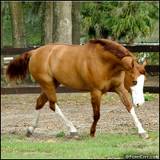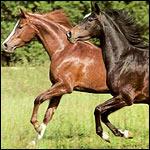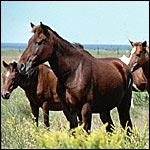 |
 |
 |
| Holistic medicine covers several alternatives and promotes natural healing. It began when traditional methods could not cure horses, and owners looked to alternatives. As more therapies receive research time and practical application it's been discovered that holistic approaches can work together with western medicine forming the current concept of complementary medicine.
Equine Chiropractic Care The treatment is based on the fact that every function of every cell, system or organ of the body is controlled by the nervous system. This nervous system is governed by the brain, which lies protected in the skull. The back bone is made up of several box shaped bones, building a joint where they connect, giving your animal's back some flexibility, and the spinal cord protection. When those bones lose their normal position or are restricted in movement, they can interfere with the nervous system. And this can be explained with the fact, that nerves leave or enter the spinal cord at precisely the position where those joints are built. Joints only have a limited range of movement, and are brought to their limit of movement almost always through an external force. |
| Some Examples:
* Stumbling and slipping * Accident/like a fall * Uneven foot balance * Conformation problems * Confinement |
| Different ways of expressing pain:
* Relunctance to work * Limb dragging * Sudden change in behavior * Relunctance to jump * Loss of impulsion |
| In 80% of cases, your horse will recover naturally through rolling, stretching or muscle toning. However, if the influence is too great or repetitive, the muscles surrounding the joint will go into spasm, creating pain. The nervous system is responsible for all body functions, and is made up of the brain, spinal cord and nerves that deliver messages back and forwards. Nerves that are involved in joint movement, will no longer carry correct impulses from the brain to the body and vice versa, as they are restricted by the misaligned joint. This is when your horse needs manipulative therapy to restore balance. Complementary to regular veterinary care, the treatment can decrease pain, improve movement and impulsion and restore health.
What will the practitioner do? The practitioner will ask you some questions about your horse, and will then analyze your horses' gait and posture. The practitioner will look for signs of muscle spasms, uneven muscle usage or postural imbalance. Using this technique, the practitioner will assess your horses' skeletal system and will then apply an adjustment with their hands only, where necessary. The adjustment is a fast but precise hand movement applied to a particular joint, stimulating your horses' in-built healing system, causing a re-alignment and restoring health. As healing is not an event but a process, it can take up to 24 hours for your horse to adjust. In this time your horse may feel stiff, tired, may drink more, or feel better right away. In some cases, this technique may not be the right form of therapy for your horse. If this is case, the practitioner has been trained to identify such a situation and will be able to give advice. |
| DISCLAIMER: Naturally Equine does not make any medical or veterinarian claims to any of the remedies or therapies listed on this site. The remedies or therapies are well known worldwide and are listed on this site for informational purposes only. |

|